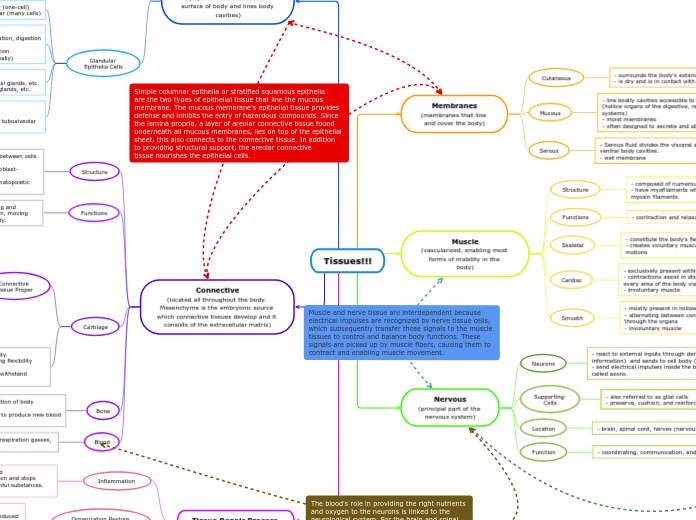Tissues!!!
Membranes
(membranes that line and cover the body)
Cutaneous
- surrounds the body's exterior (skin)
- is dry and is in contact with the atmosphere
Mucous
- line bodily cavities accessible to the external environment (hollow organs of the digestive, respiratory, and urogenital systems)
- moist membranes
- often designed to secrete and absorb
Serous
- Serous fluid divides the visceral and parietal layers of closed ventral body cavities.
- wet membrane
Muscle
(vascularized, enabling most forms of mobility in the body)
Structure
- composed of numerous muscle fibers
- have myofilaments which are complex networks of actin and myosin filaments
Functions
- contraction and relaxation, blood circulation, and mobility
Skeletal
- constitute the body's flesh
- creates voluntary muscular contractions resulting in bodily motions
Cardiac
- exclusively present within the heart's walls
- contractions assist in distributing blood to every area of the body via the blood vessels
- involuntary muscle
Smooth
- mostly present in hollow organ walls
- alternating between contracting and relaxing to propel things through the organs
- involuntary muscle
Nervous
(principal part of the nervous system)
Neurons
- react to external inputs through dendrites (receives information) and sends to cell body (interprets data)
- send electrical impulses inside the body through structures called axons.
Supporting Cells
- also referred to as glial cells
- preserve, cushion, and reinforce fragile neurons.
Location
- brain, spinal cord, nerves (nervous system)
Function
- coordinating, communication, and managing activities
Epithelial
(layer of cells that covers surface of body and lines body cavities)
Covering and Lining Epithelia Cells
- constitutes the skin's outer layer
- lines the body's open and closed cavities
- covers both internal and exterior surfaces
- Simple Epithelia (single cell layer)
- Stratified Epithelia (two or more layers)
Location: epidermis, lines organs
Functions: protection, absorption, filtration, excretion, secretion, and sensory reception
Glandular Epithelia Cells
- Unicellular (one-cell)
- Multicellular (many cells)
Functions:
- Exocrine glands: secretion, lubrication, digestion
(secretion to ducts; externally)
- Endocrine glands: hormone secretion
(secreted into bloodstream; internally)
Location:
- Endocrine Glands: pituitary, thyroid, adrenal glands, etc.
- Exocrine Glands: sweat, salivary, mucous glands, etc.
Structure of Multicellular exocrine Glands:
- simple (unbranched) or compound (branched)
- tubular (form tubes) or alveolar (form sacs) or tuboalveolar (from tubes and sacs)
Connective
(located all throughout the body. Mesenchyme is the embryonic source which connective tissues develop and it consists of the extracellular matrix)
Structure
- Ground Substance: has fibers & occupies gaps between cells
- Fibers: proteins that give stability
- Cells: immature and mature cell types (ex. fibroblast-fibrocyte)
- Blood: does not constitute the fluid matrix (hematopoietic stem cell)
Functions
- storing fuel reserves, joining and support, protection, insulation, moving materials throughout the body.
Cartilage
Connective Tissue Proper
Loose Connective Tissue:
- Areolar: Most commonly used connecting bodily parts
- Adipose: high vascularization, nutrition storage, resistance to heat loss
- Reticular: White blood cells is one cell type supported by the stroma made up of fibers.
Dense Connective Tissue:
- Dense Regular: made up of packed collagen fibers running parallel to the pull, flexible structures that withstand strain
- Dense Irregular: Thicker collagen fibers that withstand tension travelling in any direction and organized erratically
- Elastic: keeps blood flowing through arteries, permits tissue to retract after stretching, and ligaments are very elastic.
- Hyaline: offers stable foundation with flexibility.
- Elastic: possesses lots of elastic fibers allowing flexibility while maintaining the structure's shape.
- Fibrocartilage: Has tensile strength so it can withstand compressive shocks.
Bone
- remarkable capacity for protection of body structures.
- The skeleton's bones are used to produce new blood cells and store fat.
Blood
- carries nutrients, wastes, respiration gasses, and other materials.
Tissue Repair Process
Inflammation
- inflammatory chemicals released
- Clotting closes off wounded region and stops transmission of bacteria and harmful substances.
- clot forms a scab eventually
Organization Restore Blood Supply
- granulation tissue takes the place of the clot.
- growth regulators and gap-bridging collagen fibers produced by proliferating fibroblasts.
- dead cells and debris are phagocytized
- epithelial cells expand and move over granulation tissue.
Permanent Repair
- scab separates as the epithelium beneath it thickens
- resulting epithelium is entirely repaired, with a patch of tissue scarring underneath.
